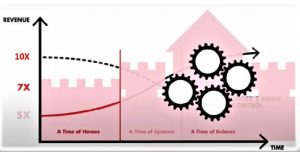How to achieve sustainable business growth requires a balance between setting up systems and maintaining a culture that promotes a founders mindset. We have spent a huge amount of time with founder companies and what they say is they don’t have a growth problem but they have a sustainable growth problem. Their issue is they can’t keep the organization growing and scaling at the pace that their revenue grows and scales. It’s in this period of early growth, these 10x growth rates that very bad things can start to happen in these companies. Here is how companies transition they grow:

-
A Time of Heroes
The first thing is, they go through a time of heroes, they are growing like crazy, they have very limited talent, and guess what happens? Well, heroes step forward and you have heroic things occurring with 26-year-olds, they do things far beyond what you’d expect them to do. These stories of heroes jumping into the breach often become some of the foundational stories of the company’s history.
The fact is, eventually, these guys get overextended and mistakes start happening and the desire of the original team is to move to a period of professionalization. This has been one of the most important issues that we’ve seen when we’ve been working with founders; how do they move to this period of professionalization without destroying the culture? It’s very hard.
-
A Time of Flawed Systems
One of the things that occur is they jump right, from unsustainable heroes to flawed systems. A lot of companies have gone through this and are now trying to put in systems as fast as they can. They are bringing in professionals, but a series of mistakes start happening;
-
-
Founders codify genius
-
First is often the original founders are asked to somehow codify their genius. They’re asked to take all the decision-making instincts and guts they have that drove the business and suddenly begin to put that into paper and to create manuals or create procedures to do what they did. One of the things that the founders have said is “I’ve now suddenly put everything I talked about in the business into a manual. And now my company is attracted to people that want to work by manual”. Who wants that?
-
-
Bring in big pros
-
Second is they bring big company recruits into the business. They get big brand names. People that have run big companies but the problem is these guys have an incumbent mindset. They’ve been administrators of large systems, but they’ve never built the system.
They come in, and they’re in charge of the supply chain. And the first thing is, “by the way, we don’t have a good supply chain, build it”. And they’re saying, “well, I expect a staff of 45 people to administer an existing supply chain”, not build one from scratch.
-
- Harmonize everything
There’s a desire to harmonize everything. This is the notion that we have gone from every company and bonus decision being made in the hallway by who sees the founder, next to the lift to we now need to get to procedures and systems for all the right reasons. This desire to harmonize means that we stop thinking about our talent and start defending our systems over our talent.
-
- Recruit like an incumbent
Then what happens is, somehow these companies feel they need to recruit like they’re an incumbent. That somehow it’s a good thing that they’re big and bureaucratic and have systems and that’s what they should recruit on. They start saying to potential recruits “come work with us because we’re a winner, we’re already safe”.
Instead of recruiting like insurgents, “this is going to be a wild ride, we have no idea what’s going on”. They begin to attract a different group of people and what happens is the tier one talent, those 26-year-olds don’t like this company anymore.
We often talk to founders and say, “Would you join now the company you’ve created”, and they pause, way too long. Many times, they say I wouldn’t ever join the company I created.
The new talent they are bringing in, is the talent that likes procedures, likes harmonization, salaries, and bonuses. They liked that they are an incumbent, and they are getting exactly the people they don’t want to come in, and they have to get rid of them. At some point, the companies realize it and the talent gap actually gets far worse.
-
A Time of Balance
This is just one example that if you were aware that companies move from unscalable heroes to flawed systems and if you can skip that step and move right to a time of balance, how much better would it be for a company’s growth? If you’re in that time of flawed systems, you need to unwind those if you expect to return to the sense of insurgency.
It’s about how do you get your heroes to walk the halls again? How do you focus your recruiting on what we call the black sheep from Blue Chips? How to achieve sustainable business growth requires that you don’t find the great recruits of great brands that like to run incumbent organizations, find the great recruits from the best brands, who were stifling there who hated the bureaucracy, and actually have an insurgent mindset.
Wrap Up
How to achieve sustainable business growth involves having systems to support your heroes, but never let your systems override the needs of your talent. You need to go through a period of professionalization without destroying the culture.

